X-ray
Latest

X-ray technique unveils mystery second figure in Degas painting
Painted around 1876, Edgar Degas' Portrait of a Woman seemed just that -- an otherwise ordinary female depiction in the artist's moody style. But as it aged in the 1920s, people started noticing a mysterious second figure emerging from beneath the first. Curious but wishing to avoid damaging the painting, conservators used a new X-ray technique to peer beyond the top layer of paint, detailed in a new paper in Scientific Reports. This unveiled a never-before-seen portrait of a woman they believe to be frequent Degas model Emma Dobigny.
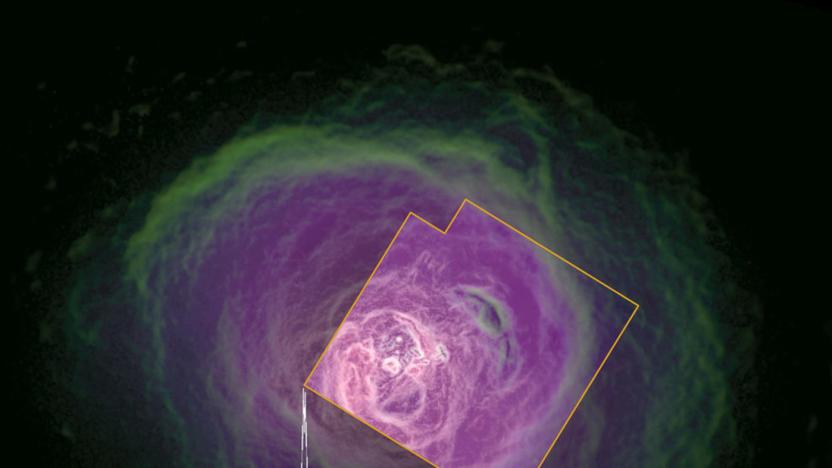
Hitomi observed the Perseus galaxy cluster before it died
Japan's most powerful x-ray satellite Hitomi got lost in space shortly after it launched, but it managed to beam back data that can help us better understand galaxy clusters. The space telescope got a chance to peer into a cluster of galaxies and its supermassive black hole in the Perseus constellation using the Goddard-built Soft X-Ray Spectrometer. Thanks to the data it sent back, astronomers found that the massive cluster's center has a "remarkably quiescent atmosphere" with fewer stars than they thought it would have.

ICYMI: Smart coats, robot whiskers and vaporizing lasers
Today on In Case You Missed It: Google and Levi's team up to make a smart Canadian Tuxedo jacket, the University of Bristol teaches a whiskered robot to react to stimuli and Stanford's Linear Accelerator fries water droplets with an X-ray laser, because science!
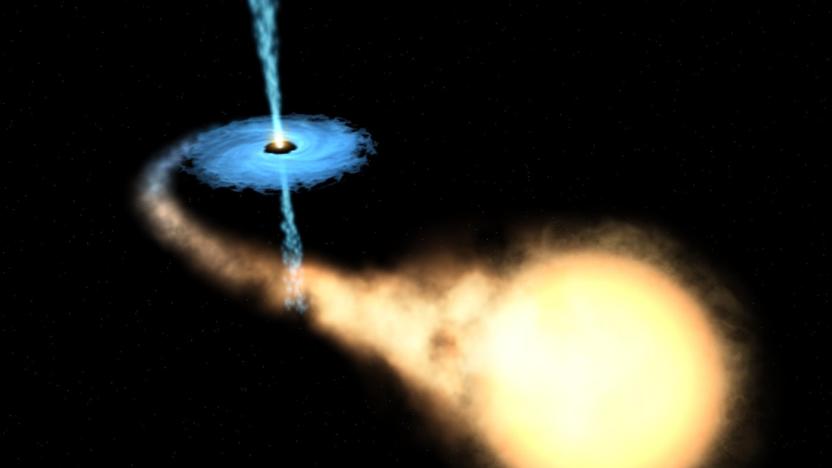
Two black holes are defying the limits of science
Even astrophysicists are occasionally surprised at what they find in the cosmos. University of Cambridge researchers have discovered that two black holes are consuming their companion stars at rates much faster than currently established limits would allow -- so fast, in fact, that the gas is ejecting at a quarter of the speed of light. To top things off, this is the first time that scientists have seen winds flowing away from ultra-luminous (and currently mysterious) X-ray sources.

Japan's most powerful X-ray satellite is dead
JAXA has given up trying to rescue its doomed X-ray satellite. The Japanese space agency has announced that it's discontinuing Hitomi's operations. Previously known as Astro-H, the x-ray observatory was designed to study black holes, galaxy clusters and other high-energy phenomena. Unfortunately, it started tumbling and spinning through space shortly after launch, ultimately losing contact with its ground team. JAXA thought the $300 million spacecraft tried to re-establish contact, but in its announcement today, the agency revealed that the signals it received were from another source altogether.
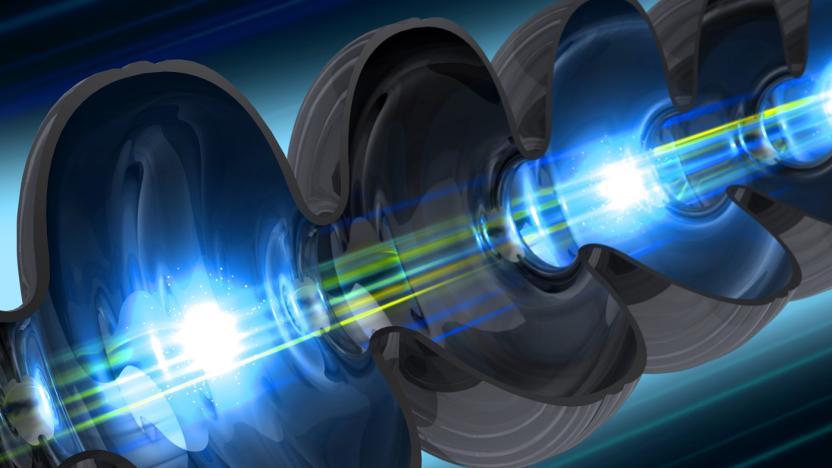
World's most powerful X-ray laser will get 10,000 times brighter
If you think that Stanford's use of an super-bright X-ray laser to study the atom-level world is impressive, you're in for a treat. The school and its partners have started work on an upgrade, LCLS-II (Linac Coherent Light Source II), whose second laser beam will typically be 10,000 times brighter and 8,000 times faster than the first -- up to a million pulses per second. The feat will require an extremely cold (-456F), niobium-based superconducting accelerator cavity that conducts electricity with zero losses. In contrast, the original laser shoots through room-temperature copper at a relatively pedestrian 120 pulses per second.

Japan is trying to rescue its tumbling X-ray satellite
Japan's JAXA space agency is struggling to figure out what happened to its Astro-H "Hitomi" satellite after it lost contact on Saturday. Radar data from the US Strategic Command's Joint Space Operations Center (JSpOC) initially showed that several parts may have broken off and JAXA's radar has spied at least one separated piece. Yesterday, scientists received intermittent signals from the craft, showing that it might be at least partially functional. However, amateur video now appears to show the $360 million X-ray telescope-equipped craft tumbling through space.
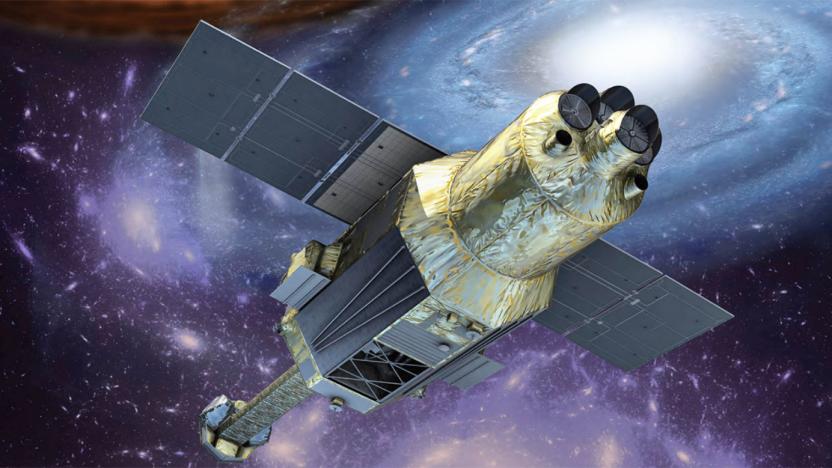
Japan's most powerful X-ray satellite went incommunicado
Japan's space agency launched its latest X-ray satellite Hitomi in February, expecting it to keep an eye on the universe for at least three years. Sadly, its future is now uncertain. JAXA lost contact with the observatory (previously called Astro-H) this weekend, and it's still trying to find out what happened to its $270 million mission. Astronomers realized something was wrong when Hitomi failed to phone home for a routine check on Sunday, March 27th, 3:40AM Eastern time. The US Joint Space Operations Center reported afterward that it spotted five pieces of debris in Hitomi's location before JAXA was supposed to hear from the satellite.
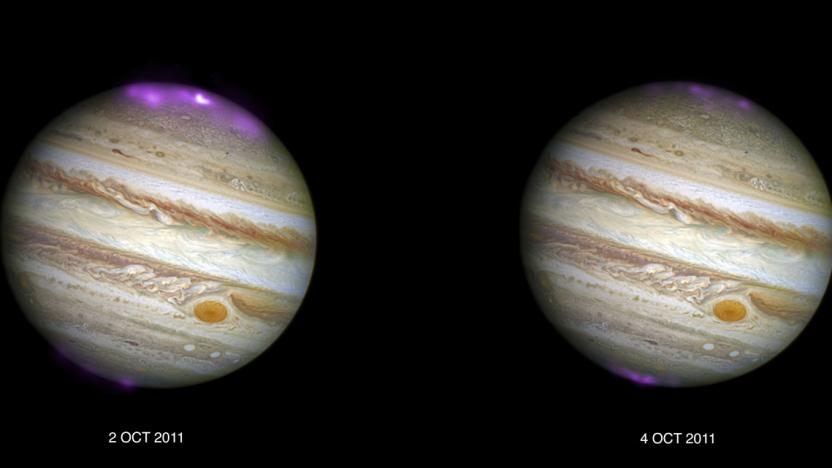
Solar storms trigger X-ray auroras on Jupiter
It's no secret that auroras are a common presence on other planets... however, you might be surprised by the ones you can't usually see. A new study using NASA's Chandra X-ray Observatory has caught solar storms creating X-ray auroras on Jupiter as they interacted with the gas giant's magnetosphere (that is, the space controlled by its magnetic field). They make Earth's northern lights seem downright quaint by comparison -- they cover areas larger than our entire home planet, and they're "hundreds of times" more energetic than what you see in the night sky.

Japan's X-ray satellite Astro-H will soon blast off to space
Japan Aerospace Exploration Agency's (JAXA) newest (and sixth!) X-ray observatory is leaving for space on Friday to study black holes and galaxy clusters. It's called Astro-H, and it's blasting off with several scientific instruments in tow. These include ones that can detect X-ray sources 10 times fainter than what its predecessor, the Suzaku, could detect. The star of the show, though, is its Soft X-Ray Spectrometer (SXS), which is fitted with a "microcalorimeter." The Goddard-built spectrometer (designed in cooperation with various Japanese institutions) will use that device to measure and distinguish X-ray colors.

Kinect sensors could lead to safer X-rays
You don't want to stand in front of an X-ray machine for any longer than necessary, and scientists have found a clever way to make that happen: the Kinect sensor you might have picked up with your Xbox. Their technique has the depth-sensing camera measuring both motion and the thickness of your body to make sure that doctors get a high-quality shot using as little radiation as possible. That's particularly important for kids, who can be sensitive to strong X-ray blasts.

The dark side of Rosetta's comet is icier than expected
The comet that the European Space Agency's Rosetta spacecraft has been chasing around the sun has a dark side. No, 67P isn't hiding any terrible secrets -- the southern hemisphere literally faces away from the sun during most of its 6.5-year-long solar orbit. Until recently, none of the cameras aboard Rosetta have been able to image it due to that utter lack of light, except for one -- the MIRO microwave instrument. NASA scientists behind the device have released a report on their observations, and lead author Mathieu Choukroun said "these unique data are telling us something very intriguing about the material just below its surface."

NASA satellite shows black hole 'bulls-eye' eruption
NASA said its Swift satellite has imaged some of "the best dust-scattered X-ray ring images ever seen" from a black hole outburst. The V404 Cygni black hole and its companion star, about 8,000 light years away, are known to eject high-energy particles every 20 years or so. Swift's X-ray telescope detected the start of a new burst on June 15th, grabbing the attention of scientists at the University of Leicester, UK. On June 30th, they captured an eruption of concentric rings from the system that covered a portion of the sky about half the diameter of the moon.

Scientists are using powerful X-rays to make better chocolate
Have you ever unwrapped a piece of chocolate only to discover that it looked a little old? That white substance that appears on the delicious confection is known as a fat bloom. As the fats in the chocolate crystallize, they form the rather unattractive white stuff. Fret not, though, a group of scientists from Nestlé, Deutsches Elektronen-Synchrotron (DESY) and the Hamburg University of Technology (TUHH) are using extremely powerful X-rays to examine exactly what causes the process. And, of course, searching for a method of avoiding the "defects." With DESY's PETRA III, which happens to be the brightest storage ring X-ray in the world, the team can examine the blooming process as it happens zoomed in to just a few nanometers. This means watching liquid fats (like cocoa butter) migrate to the surface of the chocolate. A number of factors could prevent the unsightly bloom, from storing chocolate below a certain temperature (around 65 degrees) to adjusting how porous the product is so that those migration routes are slowed. While some permanent solutions are still in the works, if you happen to come across of piece of bloom-covered candy, don't worry: it's safe to eat. [Image credit: EverJean/Flickr]

Amazon adds IMDb-fueled X-Ray for Movies to Fire TV
Amazon's X-Ray for Movies and TV Shows feature is great when you're trying to figure out the name of the actor on your screen. Today that feature is hitting Amazon Instant Video on the Fire TV, which is frankly where it should have been since the set-top box's launch. The IMDb-powered X-Ray feature brings many of the same attributes found on the Fire tablet to your television. To activate it, viewers can either pause what they are watching or press up on the remote's directional button to see the names of the actors and music playing in the current scene. Pressing up a second time drops the viewer into the full X-Ray environment with access to information about the actors, characters, music and IMDb's user-submitted trivia.

The Big Picture: NuSTAR telescope shows the sun blasting out X-rays
Pop quiz, hotshot: What do you get when you heat gas above 3 million degrees Celsius? High-energy X-rays, of course -- just the kind that NuSTAR was launched to detect. The space telescope took a break from hunting black holes to snap its first-ever shot of the sun. When that X-ray image (blue and green) is overlaid onto an infrared photo from the Solar Dynamics Observatory (in orange), it shows how X-rays relate to high-temperature solar activity like flares and sunspots. Scientists want to figure out why the sun's corona (outer atmosphere) is 1 million degrees Celsius, while the surface is a mere 6,000 degrees Celsius -- a discrepancy that's like a "flame coming out of an ice cube," according to NASA. Though it might sound risky to point the world's most sensitive high-energy X-ray telescope at the sun, it's actually quite safe -- our star emits plenty of X-rays, but very few of the high-energy type. [Image credit: NASA/JPL]

Unusual X-ray signals could reveal dark matter
Dark matter remains one of the most mysterious elements of the universe, because it's completely invisible to us. It neither emits nor absorbs light, so we can't observe it directly -- not even if we use our most powerful telescope. A team of researchers believe that they've come across important data that could change that, though: data that could lead to equipment being built especially to observe dark matter. While studying the X-ray data collected by the European Space Agency's XMM-Newton spacecraft, the team came across a spike they couldn't identify. This signal, which came from the Andromeda galaxy and the Perseus galaxy cluster, matched no other signal scientists have observed before.

The Big Picture: Galactic collision provides amazing X-ray light show
'Tis the season for holiday light shows, and two galaxies about 130 million light years from Earth got together to put on a display of their own. NGC 2207 and IC 2163, both part of the constellation Canis Major (the Great Dog), got cozy and the "ultraluminous X-ray sources" (ULXs) were on full display for NASA's Chandra X-ray Observatory to capture. In this case, the light is created when matter is pulled from stars to a neutron star or black whole, generating X-rays during the heating process. What's pictured here is a composite image of the encounter with Chandra data in pink, details from the Spitzer Space Telescope in red and info from the Hubble Space telescope in red, green and blue (seen as blue, white, orange and brown). The interaction between galaxies also features "intense star formation" thanks to shock waves that spawn during the collision.

Amazon's X-ray makes its way to Kindle for Android, at last
Amazon is finally bringing Kindle's X-ray feature to Android devices, three years after it launched and two years after it became available on iPhones and iPads. X-ray, for those who haven't had the chance to use it yet, provides some sort of an encyclopedia-and-dictionary-in-one for each book you read. It displays a list of characters and the parts of the book they appear in, particular terms and their meaning, as well as significant phrases appearing throughout the text. It works for both novels and texbooks, so long as you click the X-ray button somewhere on the app's top bar. Considering the update introduces other useful features, including push notifications and the ability to make flashcard sets, the app has now become a better tool for both schoolwork and leisure reading.

Astronomers accidentally discovered the brightest pulsar on record
Remember NuSTAR, the specialized space telescope NASA designed specifically to study black holes? It just found something much, much brighter. Astronomers at NASA have stumbled upon what appears to be the most luminous pulsar ever discovered, but they almost mistook it for a black hole. After measuring the dead star's output, they found it was outputting as much energy as 10 million suns -- shockingly powerful, considering how much smaller it is than our own star. Astronomers aren't sure why the pulsar is so bright, but will continue to study in hopes of learning how common or uncommon this kind of pulsar is. The discovery kind of shakes up what theorist knew about black holes and ultraluminous x-rays, underlining how little we really know about the universe out there. Check out NASA's gallery of images at the source link below.







